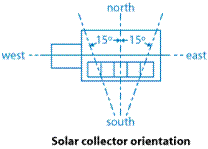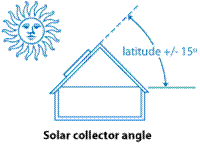Roof mounted collectors are common. Other locations around the pool that collectors can be mounted on that provides the proper exposure, orientation, and tilt toward the sun are also acceptable. Orientation and tilt of the collector affect the solar pool heating system’s performance. A knowledgeable contractor should be well versed in evaluation of the site’s solar resources and sizing the system.
COLLECTOR ORIENTATION
The orientation of the solar collectors determine the amount of daily and seasonal solar energy they receive. In studies conducted for the northern hemisphere depending on location and collector tilt, a collector may face up to 45º east or west of true south without significantly decreasing its performance. Factors such as roof orientation, local landscape features that shade the collector daily or seasonally, and local weather conditions (foggy mornings or cloudy afternoons), may affect the collector’s optimal orientation.
COLLECTOR TILT
The tilt or angle at which a collector should be set varies based on the site’s latitude and the duration of the swimming season. A general thumb rule is to set the angle of tilt to the latitude minus 10º–15º. Studies have shown that not having a collector tilted at the optimum angle will not significantly reduce system performance. Setting a collector to fit the architecture of the roof or home does not reduce its performance. However these factors should be considered in the design.
DETERMINING THE EFFICIENCY OF SOLAR SWIMMING POOL HEATING SYSTEM
The collector’s thermal performance determines the efficiency of the solar pool heating system. A solar collector’s thermal performance rating is measured by Btu (British thermal unit) per square foot per day: Btu/(ft2day) Or, the rating can be measured by megajoules (MJ) per square meter per day: MJ/(M2day)
In some cases it is measured as Btu per day, which is simply the rating in Btu/(ft2day) multiplied by the area in ft2. Some also use MJ per day, which is the rating in MJ/(M2day) multiplied by the area in M2.
Higher number usually translates to higher efficiency. Considering that weather conditions, instrumentation accuracies, and other test condition constraints may vary, the thermal performance of any two collectors within 25 BTU/( ft2day) may be considered to be equivalent. High efficiency solar collectors reduce annual operating costs and require fewer square feet of collector area to heat the pool.
COMPARING SOLAR SWIMMING POOL HEATING SYSTEM COSTS
Prior to purchasing a solar pool heating system, estimation and comparison of the costs of different solar collector models should be assessed. This exercise will help determine if potential cost savings can be realized from the use of more efficient collectors, which in turn will require fewer collector panels to heat your pool.
In order to estimate and compare costs, you will need to compute the collector’s energy output per dollar spent or invested. The formula requires the following data:
- A collector’s thermal performance rating(Btu/day)
- Total number of collector panels or piping for the area needed to heat your pool
- Total installed cost of system.
Collector’s energy output per dollar spent or invested = (Btu/day X # of collector panels/piping modules) ÷ total installed cost of system = Btu/$ per dollar spent
Example:
(27,900 X 4) Btu ÷ $3,000 = 37.20 Btu/day per dollar spent
If you just know the prices and thermal performance ratings (Btu/day) of collectors, you can use the following formula to calculate the energy output for each dollar spent or invested for different collectors:
Btu/day ÷ collector price = Btu/day per dollar spent
Example:
21,000 Btu ÷ $387 = 54.26 Btu/day per dollar spent
A careful assessment of the performance desired and the cost of the system should yield a good design at a fair price. It is also important to consider all of the factors involved in the system’s sizing and quality of the design and installation in arriving at a design that performs its intended duty.

